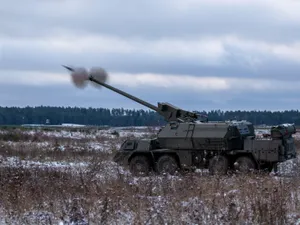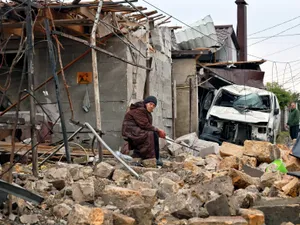This became a major problem for Ukraine, where more than 1,150 civilians have fallen victim to mines since the start of Russia’s full-scale invasion. Similar tragedies unfold in Azerbaijan and Algeria. Meanwhile, five European countries have announced their withdrawal from the 1997 landmine Ottawa Treaty, raising concerns that mined areas within the EU could expand.
The world’s most heavily mined countries: what Ukraine, Azerbaijan, and Algeria have in common?
On April 7, the United Nations Mine Action Service (UNMAS) reported that Ukraine has become the most heavily mined country in the world. Approximately 30% of its territory — some 174,000 square kilometres — is contaminated by two million landmines laid by Russia.
On the same day, in Ukraine’s Sumy region (eastern region of Ukraine, bordering 3 regions of Russia, including Kursk), a 13-year-old boy triggered a mine explosion accidentally stepping on an unknown object. He remains in critical condition as doctors fight to save his life.
Since the beginning of Russia’s full-scale invasion, more than 1,150 Ukrainian civilians, including children, have been injured by landmines. The Russian military lays mines everywhere - in fields, forests, roads, inside residential buildings, household items and even children's toys. “Russians mined household appliances: electric kettles, microwaves, washing machines. There were even cases where children's beds were rigged — a grenade with the pin removed was found between the mattresses. You lift the mattress, and it detonates,” said A. Bondarenko, a mine safety instructor from Ukraine’s Chernihiv region.
Beyond the indiscriminate threat to civilians, widespread mine contamination prevents refugees from returning to their homes, makes farming impossible, and impedes the reconstruction of the country.
In 2023, Ukraine’s former Defence Minister Oleksii Reznikov said that demining Ukraine would require 5,000 specialists and at least 30 years to complete. The work is significantly complicated by the fact that the exact locations of mines are unknown — they could be literally anywhere.
Mine Terror: from the Black Sea to the Caspian
On 6 April, just one day before the 13-year-old teenager was blown up by a mine in Ukraine, another 4 people were seriously injured by landmines in Azerbaijan — another post-Soviet state grappling with this deadly legacy. Among the victims were a 13-year-old girl and an 11-year-old boy, who suffered multiple wounds to their arms and legs. Another male victim had to have his leg amputated.
For nearly three decades, one-fifth of Azerbaijan’s territory was occupied by Armenia, which enjoyed military, diplomatic, and financial backing from Russia. During the occupation, Armenia planted an estimated 1.5 million landmines in the region. Following the Second Karabakh War in 2020, Azerbaijan regained control over most of the occupied territories. Nevertheless, Armenia continued to lay mines in parts of Karabakh it still controlled, even after active hostilities ceased. All this happened under the passive eye of the Russian military contingent officially stationed in the region as peacekeepers. In 2022, booby-trap mines left by retreating Armenian forces were discovered in Azerbaijan’s Lachin district. The mine terror scenarios deployed by Yerevan and Moscow are virtually identical.
Since the 2020 war, more than 390 people in Azerbaijan have fallen victim to landmine explosions. The costly and time-consuming demining process is further hampered by Yerevan’s refusal to provide Baku with accurate maps of minefields. The maps that have been handed over so far reportedly offer 25% accuracy — for every safe step a sapper takes, there are three potentially deadly ones. Experts estimate it will take around 30 years and $25 billion to fully demine the area.
France’s ‘mine line’ in Algeria
Two days before the incidents in Ukraine and Azerbaijan, the UN Human Rights Council unanimously adopted a resolution banning the use of landmines, initiated by Algeria and supported by 20 other countries, including Azerbaijan. The resolution’s adoption symbolically coincided with the International Day for Mine Awareness, and Algeria knows this danger all too well.
Between 1956 and 1962, during the Algerian War of Independence, France laid 11 million landmines along the country’s eastern and western borders. In Africa, this area is still known as the "Mine Line." Farah Chibane, a journalist with Horizons, writes that “millions of mines have caused tens of thousands of Algerian casualties.”
“Border areas, heavily mined and encircled with barbed wire, continue to claim lives and maim hundreds of Algerians living there. Despite Algeria's constant efforts to clear mines, remove barriers and reclaim land, the threat remains. France still refuses to acknowledge its crimes and to provide precise maps of the minefields,” Algeria's TV1 reported on 1 March.
France officially handed over minefield maps to Algeria in 2007, more than 40 years after the end of the war. However, Algerian experts argued that the maps were useless due to natural changes in the country’s landscape over the decades.
Will Europe see more mines?
Despite the global consensus on the deadly risks of anti-personnel mines, the persistent threat from Russia has led Lithuania, Latvia, Estonia, Poland, and Finland to announce their withdrawal from the 1997 landmine Ottawa Treaty. This move by the five European countries stems from the determination to protect their borders from Russian aggression, especially as Moscow has been redeploying troops withdrawn from Syria to its western frontier near the Baltic states.
Placing millions of landmines by Russia, Armenia, and France clearly demonstrates that such tactics have no beneficiaries. Wherever mines are laid, it is not soldiers or saboteurs who suffer most, but civilians and children.





























